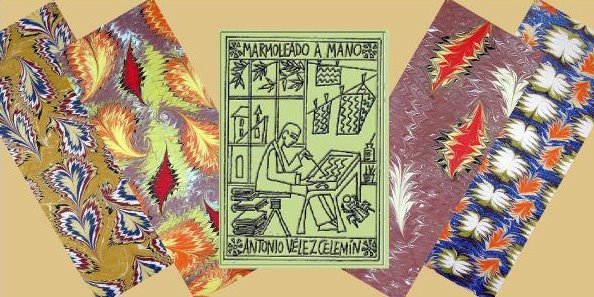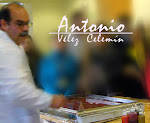*******************************************











Suminagashi is the japanese way of marbling.
Literally: "floating black ink".
In the past Leyden fair, Aaldert, from Boektotaal,
gave a demonstration of this technique.
Literally: "floating black ink".
In the past Leyden fair, Aaldert, from Boektotaal,
gave a demonstration of this technique.

The arrangements could be seen by the public,
and spectacular means were used.
It is necessary to prepare the ink meticulously
so that it could float perfectly on a tray of pure water.
and spectacular means were used.
It is necessary to prepare the ink meticulously
so that it could float perfectly on a tray of pure water.

When everything is ready,
by using two brushes,
one loaded with ink
and the other with a dispersing agent,
a drop of every brush is left
on the surface of the water,
and at the end the tray will be full of concentric circles
formed by the alternation of the two
substances.
At this moment the air can appear,
it will help us if we have a fan at hand.
by using two brushes,
one loaded with ink
and the other with a dispersing agent,
a drop of every brush is left
on the surface of the water,
and at the end the tray will be full of concentric circles
formed by the alternation of the two
substances.
At this moment the air can appear,
it will help us if we have a fan at hand.

An original and unique design will be got on every paper.

Although, I have to say that Aaldert does not like that thing with the fan and
he did not use it in his demonstration.
***
he did not use it in his demonstration.
***
The most traditional suminagashi was done with black ink,
but later the blue ink and the red one were added.
The paper opening this article,
from the doctor Sidney Berger’s collection, in Boston,
it is a good example.
With it we can see clearly
the aspect of these papers.
but later the blue ink and the red one were added.
The paper opening this article,
from the doctor Sidney Berger’s collection, in Boston,
it is a good example.
With it we can see clearly
the aspect of these papers.
They exist documents dated in the XIIth century
with calligraphy executed with suminagashi as a background,
therefore it is believed that this technique is probably millennial.
with calligraphy executed with suminagashi as a background,
therefore it is believed that this technique is probably millennial.

The above scene is the XII sutra
of the
Semmen Koshakyo.
I like it so much that I asked my sister Adela
to paint a copy for me, oil on table,
this one shown here and that I have in my office,
so I can enjoy it every day.
It has everything:
the shape of a fan,
the calligraphy,
the miniature...
...and the suminagashi.
Notice how the painter respected the suminagashi background
and drew the figure of the left in two parts.
of the
Semmen Koshakyo.
I like it so much that I asked my sister Adela
to paint a copy for me, oil on table,
this one shown here and that I have in my office,
so I can enjoy it every day.
It has everything:
the shape of a fan,
the calligraphy,
the miniature...
...and the suminagashi.
Notice how the painter respected the suminagashi background
and drew the figure of the left in two parts.
Today suminagashi is known in the whole world and
the list of artists who use it
and transform it is endless.
the list of artists who use it
and transform it is endless.

This tree is one of the most typical compositions
of
Milena Hughes.
At first sight one knows it is hers.
****
Sometimes I have tried to make suminagashi,
and if I have got something it has been by chance.
This paper reminds me "The big wave" by Hiroshigue,
one of the artists of the Ukiyo- e,
the famous japanese pictures of the Edo period.

of
Milena Hughes.
At first sight one knows it is hers.
****
Sometimes I have tried to make suminagashi,
and if I have got something it has been by chance.
This paper reminds me "The big wave" by Hiroshigue,
one of the artists of the Ukiyo- e,
the famous japanese pictures of the Edo period.


But my fan changed the sacred mount Fuji
in a kind of polar bear.
And this takes me where I wanted to be.
The other day I typed in “google”, in images:
"Harunobu".
Another artist of the same period:
Suzuki Harunobu (c. 1724-1770)
Do you know what has happened?
That the third image that appeared in my computer was this one:
"The big monkey"
in a kind of polar bear.
And this takes me where I wanted to be.
The other day I typed in “google”, in images:
"Harunobu".
Another artist of the same period:
Suzuki Harunobu (c. 1724-1770)
Do you know what has happened?
That the third image that appeared in my computer was this one:
"The big monkey"

A comical interpretation,
it is I who says,
of what does this artist thought about the couples relations.
Let’s say... about who of the two wears the pants at home.
It is an engraving and the suminagashi has been printed on a wooden block,
just as the rest of the drawing.
It is not a true suminagashi,
it is an evocation of it that does not indicate another thing
than the respect of the artist towards the venerable tradition,
the same feeling of the fan’s miniaturist.
Harunobu did not do something like this only one time.
He repeated it in another engraving,
"Kanzan and Jittoku"
two monks studying a love letter,
some burlesque personages of the epoch of Tang dynasty (618-907).
it is I who says,
of what does this artist thought about the couples relations.
Let’s say... about who of the two wears the pants at home.
It is an engraving and the suminagashi has been printed on a wooden block,
just as the rest of the drawing.
It is not a true suminagashi,
it is an evocation of it that does not indicate another thing
than the respect of the artist towards the venerable tradition,
the same feeling of the fan’s miniaturist.
Harunobu did not do something like this only one time.
He repeated it in another engraving,
"Kanzan and Jittoku"
two monks studying a love letter,
some burlesque personages of the epoch of Tang dynasty (618-907).

I knew this engraving long ago,
I even saw it last year in Barcelona,
in an exhibition on the Ukiyo- e in the “Pedrera”,
the Gaudí building,
because in Barcelona pleasures never come alone, but in pairs...
...at least.
I got the surprise the other day by having found "The big monkey" for the first time.
I knew that Harunobu had used also a suminagashi background in this engraving,
and an auction allowed me to watch it finally.
Now, you can enjoy the two engravings simultaneously.
Something that has been hard for me to get,
I could obtain both only over much time and a lot of luck.
But if you do a foul-up to yourselves with the japanese word
I can recommend to you a short cut.
You can pronounce it as all people do it
when they hear this word for the first time:
s u m i... W H A T?
I even saw it last year in Barcelona,
in an exhibition on the Ukiyo- e in the “Pedrera”,
the Gaudí building,
because in Barcelona pleasures never come alone, but in pairs...
...at least.
I got the surprise the other day by having found "The big monkey" for the first time.
I knew that Harunobu had used also a suminagashi background in this engraving,
and an auction allowed me to watch it finally.
Now, you can enjoy the two engravings simultaneously.
Something that has been hard for me to get,
I could obtain both only over much time and a lot of luck.
But if you do a foul-up to yourselves with the japanese word
I can recommend to you a short cut.
You can pronounce it as all people do it
when they hear this word for the first time:
s u m i... W H A T?
Copyrights: My gratitude to Aaldert, to doctor Berger and to Milena Hughes for his kind authorization to include their images. The engravings can be founded freely on the internet from some art galleries.












2 comments:
On the following page you can find an interesting article on Harunobu's excellent pupil Isoda Koryusai (act.1770-1790s)
Click here for more articles on Ukiyo-e woodblock prints by for instance: Kuniyoshi, Utamaro, Hokusai, Shunga (erotic prints)...etc.
Thank you very much for your collaboration, I really appreciate it.
Post a Comment